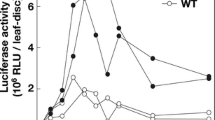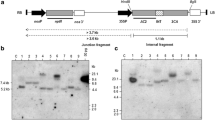Abstract
Gene silencing is one of the limiting factors for transgene expression in plants. But the plant viruses have learnt to suppress gene silencing by encoding the protein(s), called RNA silencing suppressor(s) (RSS). Hence, these proteins could be used to overcome the limitation for transgene expression. The RNAi suppressors, namely HC-Pro and P19, have been shown to enhance the transgene expression but other RSS proteins have not been screened for similar role. Moreover, none of RSSs from the DNA viruses are known for enhancing the expression of transgenes. The Mungbean Yellow Mosaic India Virus (MYMIV) belonging to the genus Begomovirus within the family of Geminiviridae encodes an RSS called the AC2 protein. Here, we used AC2 to elevate the expression of the transgenes. Upon introduction of MYMIV-AC2 in the silenced GFP transgenic tobacco lines, by either genetic hybridisation or transgenesis, the GFP expression was enhanced several fold in F1 and T0 lines. The GFP-siRNA levels were much reduced in F1 and T0 lines compared with those of the initial parental silenced lines. The enhanced GFP expression was also observed at the cellular level. This approach was also successful in enhancing the expression of another transgene, namely topoisomeraseII.








Similar content being viewed by others
Abbreviations
- GM:
-
Genetically modified
- PTGS:
-
Post-translational gene silencing
- TGS:
-
Transcriptional gene silencing
- RNAi:
-
RNA interference
- RdRP:
-
RNA-dependent RNA polymerase
- MYMIV:
-
Mungbean Yellow Mosaic India Virus
- VIGS:
-
Virus-induced gene silencing
- GFP:
-
Green florescent protein
- RSS:
-
RNA silencing suppressors
- CaMV:
-
Cauliflower mosaic virus
- MiRs:
-
Micro-RNAs
References
Schillberg, S., Fischer, R., & Emans, N. (2003). ‘Molecular farming’ of antibodies in plants. Naturwissenschaften, 90, 145–155.
Thanavala, Y., Huang, Z., & Mason, H. S. (2006). Plant-derived vaccines: a look back at the highlights and a view to the challenges on the road ahead. Expert Review of Vaccines, 5, 249–260.
Fischer, R., & Emans, N. (2000). Molecular farming of pharmaceutical proteins. Transgenic Research, 9, 279–299.
Sorrentino, A., Schillberg, S., Fischer, R., Porta, R., & Mariniello, L. (2009). Molecular farming of human tissue transglutaminase in tobacco plants. Amino Acids, 36, 765–772.
De Wilde, C., Van Houdt, H., De Buck, S., Angenon, G., De Jaeger, G., & Depicker, A. (2000). Plants as bioreactors for protein production: avoiding the problem of transgene silencing. Plant Molecular Biology, 43, 347–359.
Fagard, M., & Vaucheret, H. (2000). (Trans)gene silencing in plants: How many mechanisms? Annual Review Plant Physiology Plant Molecular Biology, 51, 167–194.
Alvarez, M. L., Pinyerd, H. L., Topal, E., & Cardineau, G. A. (2008). P19-dependent and P19-independent reversion of F1-V gene silencing in tomato. Plant Molecular Biology, 68, 61–79.
Buchon, N., & Vaury, C. (2006). RNAi: a defensive RNA-silencing against viruses and transposable elements. Heredity, 96, 195–202.
Waterhouse, P. M., Wang, M. B., & Lough, T. (2001). Gene silencing as an adaptive defence against viruses. Nature, 411, 834–842.
Li, F., & Ding, S. (2006). Virus counterdefense: diverse strategies for evading the RNA-silencing immunity. Annual Review Microbiology, 60, 503–531.
Karjee, S., Islam, M. N., & Mukherjee, S. K. (2008). Screening and identification of virus-encoded RNA silencing suppressors. Methods in Molecular Biology, 442(Karjee S), 187–203.
Singh, D. K., Karjee, S., Malik, P. S., Islam, N. & Mukherjee, S. K. (2007). DNA replication and pathogenecity of MYMIV. In Communicating Current research and Educational Topics and Trends in Applied Microbiology, vol. 1: FORMATEX Microbiology series no 1 (Méndez–Vilas, A. B., ed.), Spain, FORMATEX, pp 155–162.
Bisaro, D. M. (2006). Silencing suppression by geminivirus proteins. Virology, 344(1), 158–168.
Trinks, D., Rajeswaran, R., Shivaprasad, P. V., Akbergenov, R., Oakeley, E. J., Veluthambi, K., et al. (2005). Suppression of RNA silencing by geminivirus nuclear protein, AC2, correlates with transactivation of host gene. Journal of Virology, 79, 2517–2527.
Haley, A., Zhan, X. C., Richardson, K., Head, K., & Morris, B. (1992). Regulation of the activities of African cassava mosaic virus promoters by the AC1, AC2 and AC3 gene products. Virology, 188, 905–909.
Rajeswaran, R., Sunitha, S., Shivaprasad, P. V., Pooggin, M. M., Hohn, T., & Veluthambi, K. (2007). The Mungbean yellow mosaic begomovirus transcriptional activator protein transactivates the viral promoter-driven transgene and causes toxicity in transgenic tobacco. Molecular Plant-Microbe Interactions, 20, 1545–1554.
Shivaprasad, P. V., Akbergenov, R., Trinks, D., Rajeswaran, R., Veluthambi, K., Hohn, T., et al. (2005). Promoters, transcripts, and regulatory proteins of mungbean yellow mosaic geminivirus. Journal of Virology, 79, 8149–8163.
Sunter, G., & Bisaro, D. M. (1991). Transactivation in a geminivirus: AL2 gene product is needed for coat protein expression. Virology, 180, 416–419.
Sunter, G., & Bisaro, D. M. (1992). Transactivation of geminivirus AR1 and BR1 gene expression by the viral AL2 gene product occurs at the level of transcription. The Plant Cell, 4, 1321–1331.
Sunter, G., & Bisaro, D. M. (1997). Regulation of a geminivirus coat protein promoter by AL2 protein (Trap): Evidence for activation and derepression mechanisms. Virology, 232, 269–280.
Voinnet, O., Pinto, Y. M., & Baulcombe, D. C. (1999). Suppression of gene silencing: a general strategy used by diverse DNA and RNA viruses of plants. Proceedings of the National Academy of Sciences of the United States of America, 96, 14147–14152.
Hartitz, M. D., Sunter, G., & Bisaro, D. M. (1999). The geminivirus transactivator (TrAP) is a single-stranded DNA and zinc-binding phosphoprotein with an acidic activation domain. Virology, 263, 1–14.
Mallory, A. C., Parks, G., Endres, M. W., Baulcombe, D., Bowman, L. H., Pruss, G. J., et al. (2002). The amplicon-plus system for high-level expression of transgenes in plants. Nature Biotechnology, 20, 622–625.
Voinnet, O., Rivas, S., Mestre, P., & Baulcombe, D. (2003). An enhanced transient expression system in plants based on suppression of gene silencing by the p19 protein of tomato bushy stunt virus. The Plant Journal, 33, 949–956.
Horsch, R. B., Fry, J. E., Hoffmann, N. L., Eichholtz, D., Rogers, S. G., & Fraley, R. T. (1985). A simple and general method for transferring genes into plants. Science, 227, 1229–1231.
Sharma, A. D., Gill, P. K., & Singh, P. (2002). DNA isolation from dry and fresh samples of polysaccharide-rich plants. Plant Mol Biol Reporter, 20, 415a–415f.
Bart, R., Chern, M., Park, C. J., Bartley, L., & Ronald, P. C. (2006). A novel system for gene silencing using siRNAs in rice leaf and stem-derived protoplasts. Plant Methods, 2006(2), 13.
Pham, X. H., Reddy, M. K., Ehtesham, N. Z., Matta, B., & Tuteja, N. (2000). A DNA helicase from Pisum sativum is homologous to translation initiation factor and stimulates topoisomeraseI activity. The Plant Journal, 24, 219–229.
Anandalakshmi, R., Pruss, G. J., Ge, X., Marathe, R., Mallory, A. C., Smith, T. H., et al. (1998). A viral suppressor of gene silencing in plants. Proceedings of the National Academy of Sciences of the United States of America, 95, 13079–13084.
Kasschau, K. D., & Carrington, J. C. (1998). A counterdefensive strategy of plant viruses: suppression of posttranscriptional gene silencing. Cell, 95, 461–470.
Ma, P., Liu, J., He, H., Yang, M., Li, M., Zhu, X., et al. (2009). A viral suppressor P1/HC-pro increases the GFP gene expression in Agrobacterium-mediated transient assay. Applied Biochemistry and Biotechnology, 158(2), 243–252.
Mallory, A. C., Ely, L., Smith, T. H., Marathe, R., Anandalakshmi, R., Fagard, M., et al. (2001). HC-Pro suppression of transgene silencing eliminates the small RNAs but not transgene methylation or the mobile signal. The Plant Cell, 13, 571–583.
Voinnet, O. (2009). Origin, biogenesis, and activity of plant microRNAs. Cell, 136, 669–687.
Chapman, E. J., Prokhnevsky, A. I., Gopinath, K., Dolja, V. V., & Carrington, J. C. (2004). Viral RNA silencing suppressors inhibit the microRNA pathway at an intermediate step. Genes & Development, 18, 1179–1186.
Chellappan, P., Vanitharani, R., & Fauquet, C. M. (2005). MicroRNA-binding viral protein interferes with Arabidopsis development. Proceedings of the National Academy of Sciences of the United States of America, 102, 10381–10386.
Dunoyer, P., Lecellier, C. H., Parizotto, E. A., Himber, C., & Voinnet, O. (2004). Probing the microRNA and small interfering RNA pathways with virus-encoded suppressors of RNA silencing. The Plant Cell, 16, 1235–1250.
Kasschau, K. D., Xie, Z., Allen, E., Llave, C., Chapman, E. J., Krizan, K. A., et al. (2003). P1/HC-Pro, a viral suppressor of RNA silencing, interferes with Arabidopsis development and miRNA function. Developmental Cell, 4, 205–217.
Mallory, A. C., Dugas, D. V., Bartel, D. P., & Bartel, B. (2004). MicroRNA regulation of NACdomain targets is required for proper formation and separation of adjacent embryonic, vegetative, and floral organs. Current Biology, 14, 1035–1046.
Park, W., Li, J., Song, R., Messing, J., & Chen, X. (2002). CARPEL FACTORY, a Dicer homolog, and HEN1, a novel protein, act in microRNA metabolism in Arabidopsis thaliana. Current Biology, 12, 1484–1495.
Siddiqui, S. A., Sarmiento, C., Truve, E., Lehto, H., & Lehto, K. (2008). Phenotypes and functional effects caused by various viral RNA silencing suppressors in transgenic Nicotiana benthamiana and N. tabacum. Molecular Plant-Microbe Interactions, 21, 178–187.
Stav, R., Hendelman, A., Buxdorf, K., & Arazi, T. (2010). Transgenic expression of tomato bushy stunt virus silencing suppressor P19 via the pOp/LhG4 transactivation system induces viral-like symptoms in tomato. Virus Genes, 40, 119–129.
Bastar, M. T., Luthar, Z., Škof, S., & Bohanec, B. (2004). Quantiative determination of mosaic GFP gene expression in tobacco. Plant Cell Reports, 22, 939–944.
Taniguchi, Y., Choi, P. J., Li, G. W., Chen, H., Babu, M., Hearn, J., et al. (2010). Quantifying E. coli proteome and transcriptome with single molecule sensitivity in single cells. Science, 329, 533–538.
Acknowledgements
We acknowledge Professor David C. Baulcombe, UK for providing the mGFP gene. We are also thankful to Professor M. V. Rajam, Delhi University South Campus for providing the TOPOII transgenic T2 tobacco lines. We thank Dr. M. N. Islam for his initial efforts to develop GFP-silenced lines. This research was supported by grants from International Centre for Genetic Engineering and Biotechnology (ICGEB) and Department of Biotechnology, New Delhi, India. The financial assistance of DBT and CSIR (India) to SM and SK are duly acknowledged.
Author information
Authors and Affiliations
Corresponding author
Rights and permissions
About this article
Cite this article
Rahman, J., Karjee, S. & Mukherjee, S.K. MYMIV-AC2, a Geminiviral RNAi Suppressor Protein, Has Potential to Increase the Transgene Expression. Appl Biochem Biotechnol 167, 758–775 (2012). https://doi.org/10.1007/s12010-012-9702-z
Received:
Accepted:
Published:
Issue Date:
DOI: https://doi.org/10.1007/s12010-012-9702-z




